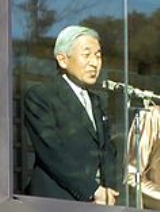
, "the symbol of the state and of the unity of the people." He is a ceremonial figurehead under a form of constitutional monarchy
and is head of the Japanese Imperial Family
with functions as head of state
. He is also the highest authority of the Shinto
religion. In his dual role as head of a religion and head of state the Emperor resembles the British monarch, who is "supreme governor" of the Church of England
.
The Emperor is called the Tennō (天皇) in Japanese, literally meaning "heavenly sovereign".
1308 The reign of Emperor Hanazono, emperor of Japan, begins.
1586 Emperor Go-Yozei becomes Emperor of Japan.
1867 The 15th and the last military Shogun of the Tokugawa shogunate resigns in Japan, returning his power to the Emperor of Japan and thence to the re-established civil government of Japan
1869 The Japanese daimyō begin returning their land holdings to the emperor as part of the Meiji Restoration reforms. (Traditional Japanese Date: June 17, 1869).
1945 Japan accepts the Allied terms of surrender in World War II and the Emperor records the Imperial Rescript on Surrender (August 15 in Japan standard time).
1959 Akihito, future Emperor of Japan, weds Michiko.
1992 Emperor Akihito becomes the first Emperor of Japan to stand on Chinese soil.

